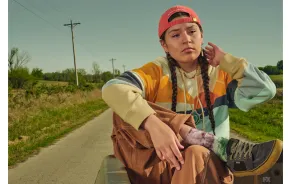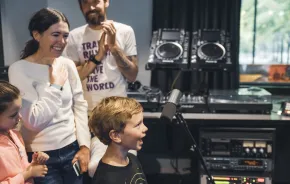When 11-year-old Riley is uprooted from her home in Minnesota for a new life in San Francisco, her emotions are thrown into turmoil. Inside Out, Pixar's 15th feature film (which screened at SIFF and opens in theaters nationwide on Friday, June 19), takes place inside Riley's head, where the muppet-like personifications of Joy, Anger, Fear and Disgust each have important roles to play in managing Riley's response to circumstances.
Sadness is there, too, voiced by Phyllis Smith of The Office, but the other emotions don't have much use for her. However, when San Francisco turns out not to be as wonderful as Riley hoped, Sadness begins to infect everything, triggering a spiral into emotional chaos as Joy (brilliantly voiced by Amy Poehler) tries to maintain control.
The adventures that follow compose an extended metaphor for emotional psychology that in almost any other hands would quickly become tiresome. Instead, Pixar maintains a delicate balance in which the metaphor serves the story without ever becoming strained. In fact, each new visual representation of mental activity is delightful in its cleverness. Shifts from Riley's internal workings to her external situations lend emotional weight to the film. Having established the importance of “core memories” to Riley's developing personality, the formation of her first sad core memory during a crushing first day in a new school raises the stakes of the otherwise flimsy scenario of moving to a new town.

Pixar has never shied away from taking a stand on parenting styles (or lifestyles), defending risk-taking in Finding Nemo, rejecting conformity in The Incredibles and Brave, and condemning overindulgence in Wall-E. Turns out that Inside Out has a message for parents, too. After Riley tries to run away, she apologizes not for the runaway attempt, but for failing to be the happy girl her parents expect her to be. Ultimately, Inside Out is a defense of sadness. Joy's value is self-evident, Fear keeps us safe, Disgust keeps us from getting poisoned (or embarrassed) and Anger defends justice. But it takes the whole movie to discover the value of Sadness (hint: it has to do with empathy).
Like all good stories, Inside Out follows the dictum to “show, don't tell.” Three out of four members of my family cried at least once during the movie.
Inside Out is emotional by definition, but it's not maudlin. Amy Poehler's talent is not wasted, and running gags are threaded throughout: the indestructible long-term memory of a chewing-gum commercial jingle; Riley's mom hanging on to the memory of the Brazilian helicopter pilot she turned down in favor of Riley's dad. Many of the movie's funniest moments come from glimpses into other characters' heads; with the visual framework strongly established in Riley, whole stories can be told in a few quick images.
Parents should know: Is it right for my kid?
First the topline: Inside Out is rated PG, but I would recommend it for all ages.
As much as I love Pixar, my own daughter didn't watch most of their movies until she was in school. Finding Nemo's angler fish gave her nightmares, as did the mutilated toys next door in Toy Story. Inside Out is as lushly animated as the other Pixar films, but saves most of the intense visuals for the humorous and wondrous elements of the story. There isn't much that could be scary, except for the descent into Riley's subconscious, where her deepest fears live – and even this won't be challenging unless your child shares Riley's fears of birthday clowns and Grandma's vacuum cleaner. Even Riley's nightmare is more wacky than frightening.
Although there are no disturbing elements, there are lots of potential conversation starters in a movie whose point is that it's okay – even important – to feel sad sometimes. Kids can be encouraged to talk about their own feelings and how they manage them. Parents can talk about how feelings can guide us to make good or bad decisions but how they are all valuable and we shouldn't try to ignore them. Parents can also explain that talking about feelings, especially to parents, can help children deal with them. Leaving the theater, though, the conversation I heard most from kids and adults was the one where people identified their own favorite/dominant emotion character. My 11-year-old was taken with Mindy Kaling's stylish Disgust.

If you go...
Where and when: Inside Out opens in theaters everywhere on June 19.
Technical details: If you are among those who get eye strain and headaches from 3-D movies, you'll be glad to know that the 3-D effect is not as pronounced in this movie as in more action-oriented movies. Smaller children may have a hard time keeping 3-D glasses on their heads. Check with the theater to see if child-size glasses are available, or consider attending a standard digital presentation if you are bringing preschoolers.











